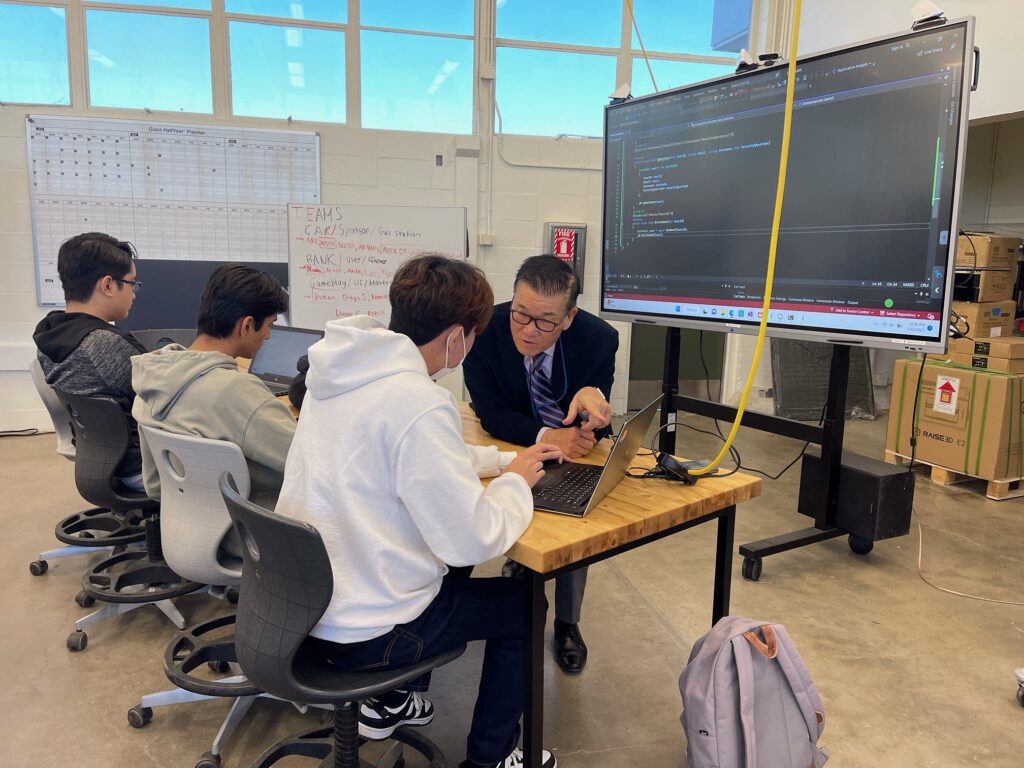
Anaheim Union High School District students discuss their work with Superintendent Michael Matsuda.
Courtesy: Anaheim Union High School District
Traditional measures of academic success, long dominated by elite universities, have often perpetuated systems of exclusivity rather than fostering true opportunity.
As the superintendent of a high school district in Southern California, I have frequently heard major employers express concern that graduates from top UC and private universities often lack essential skills in project management, basic interpersonal abilities and the capacity for creativity and innovation. This reveals a significant mismatch between K-12 education, higher education and the demands of the modern workforce.
Elite universities have long depended on rigid criteria — high test scores in math and English, advanced coursework like calculus and AP classes, and curated extracurricular activities — to determine which students gain admission. But these metrics often favor those with access to private tutors, well-funded schools and the insider knowledge of the admissions process provided by college admission coaches. As a result, this system excludes many students who possess extraordinary talents but lack the means to navigate these traditional pathways.
The narrow definition of success currently used by elite universities creates two major problems. First, it reduces student potential to a set of numbers and polished narratives, ignoring qualities like resilience, emotional intelligence and social impact. Second, it fails to recognize students who may excel in less conventional but equally critical domains, such as interpersonal skills and the ability to creatively solve problems. By relying on these outdated measures, the current system not only limits individual opportunities but also deprives society of the diverse perspectives needed to solve complex challenges.
In response, districts like Anaheim Union High School District are pioneering new ways to assess and celebrate student success through what we call the 5Cs: critical thinking, creativity, collaboration, communication and compassion. This approach challenges outdated definitions of “college and career readiness” and offers a more holistic vision for the future.
In collaboration with UC Irvine professor June Ahn and the nonprofit education technology organization eKadence, Anaheim Union is developing and piloting an AI-enhanced learning strategy that redefines how student talent is measured.
Much as a student driver reflects on what went wrong after failing a driving test or how a coach has a team analyze their mistakes after losing a big game, the district is embedding structured reflection into student learning. After completing a major unit or project, students engage in written or oral reflections, considering what they did well, where they struggled and how they can improve. These reflections are then fed into an artificial intelligence (AI) analysis, designed and tested by Ahn’s team, that immediately generates a summary for both the student and the teacher. The AI not only highlights the main reflection points but also provides actionable advice for growth.
Going Deeper
See an example of the student input and AI analysis of one student’s project work here.
For example, if a student works on a community-based project to address food insecurity and later reflects on how they struggled with organizing team meetings but excelled in presenting their findings, the UC Irvine AI tool will capture these insights. It might suggest strategies for better time management or offer communication techniques to improve team coordination. This iterative process ensures that students are not only gaining subject knowledge but also developing essential life skills.
One of the most promising aspects of this AI-enhanced learning strategy is its potential to influence college admissions. Universities are increasingly questioning the efficacy of traditional criteria, especially in light of decisions to eliminate SAT/ACT test requirements. The tool we are developing provides a scalable addition to current criteria: a portfolio of AI-summarized reflections that highlight a student’s strengths that cannot be measured by test scores or in an essay.
Imagine a college admissions officer reviewing an applicant’s portfolio. Instead of a single GPA or test score, they see a dynamic narrative of growth and impact — how a student led a community project addressing food insecurity, demonstrating compassion and collaboration, or how they developed an innovative solution to a STEM challenge, showcasing critical thinking and creativity. Such a system not only makes admissions more equitable but also better aligns with what colleges and employers increasingly value: adaptable, motivated and socially conscious individuals.
The future of education depends on dismantling systems that reward the old factory model — which benefits some students and sidelines others — and replacing them with models that recognize and nurture diverse forms of excellence. This approach offers a road map for how school districts across California can empower all students to transcend traditional barriers and realize their full potential. If adopted widely, it could transform not only K-12 education but also college admissions, workforce development and society at large.
The question is no longer whether change is necessary, but how quickly we can scale up innovations like this to ensure that every student has the opportunity to thrive. By embracing this shift, we can create a more just, dynamic, and inclusive educational system — one that values every student for who they are and what they contribute to the world.
•••
Michael Matsuda is superintendent of the Anaheim Union High School District. June Ahn is a professor of learning sciences and research-practice partnerships at the UC Irvine School of Education.
The opinions expressed in this commentary represent those of the authors. EdSource welcomes commentaries representing diverse points of view. If you would like to submit a commentary, please review our guidelines and contact us.

